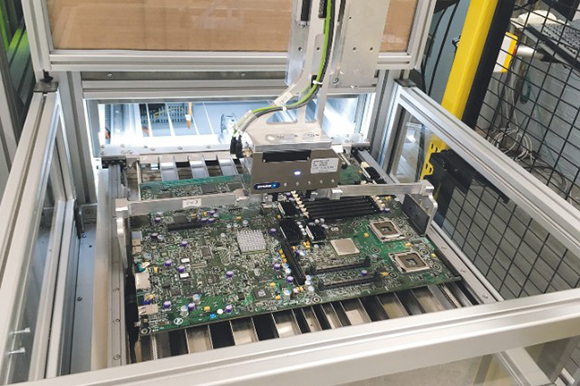Fraunhofer ILT’s ADIR project develops recycling concept for raw materials
April 30, 2020

The Fraunhofer Institute for Laser Technology (ILT), based in Aachen, Germany, reports that the four-year EU research project ADIR – ‘Next generation urban mining – Automated disassembly, separation and recovery of valuable materials from electronic equipment’ – which set out to develop a completely new, automated method of recycling electronic devices by disassembling them and recovering the valuable raw materials they contain, has concluded.
Led by Fraunhofer ILT, and involving eight project partners from three countries, the ADIR project’s strategic goal was to reduce the EU’s dependency on natural resources, reduce the need for costly imports of raw materials, and demonstrate new technologies for ‘inverse production’.
The new recycling concept focuses in particular on the elements tantalum, neodymium, tungsten, cobalt and gallium. Found in virtually every modern electronic device, these metals are valuable due to their scarcity, their cost – which in some cases is close to €250 per kilogram – and the tremendous difficulty of recovering them from used electronic devices in a cost-effective way.
The ADIR project consortium demonstrated the efficiency of its new recycling concept by disassembling around 1000 mobile phones and over 800 circuit boards from computers. The results were presented at the Berlin Recycling and Raw Materials Conference from March 2–3, 2020, and at the Mineral Recycling Forum on March 10, 2020 in Aachen.
Fraunhofer ILT explains that ‘urban mining’, which refers to the recovery of secondary raw materials from buildings, infrastructure or products, is an increasingly important trend, which inspired Prof Reinhard Noll and Dr Cord Fricke-Begemann from Fraunhofer ILT to take a new approach to recycling. Together with the ADIR project partners, they developed a concept for the piece-by-piece processing of circuit boards from computers and obsolete mobile phones. Support for the robotics R&D required for the project came from the Fraunhofer Institute for Factory Operation and Automation (IFF) in Magdeburg, Germany.
The ADIR project revolves around automated, flexible processes designed to disassemble electronic devices to selectively extract valuable component parts at the end of their useful life. The disassembly plant relies on an intelligent combination of laser technology, robotics, vision systems and information technology. Lasers play one of the key roles, performing tasks such as identifying what each component consists of and desoldering or cutting components out of the board in a fast, non-contact process. The patented procedure is believed to be an efficient means of recovering strategically important materials of high economic value on an industrial scale.
The project team reports that it has already received very positive feedback from experts at numerous events, especially among attendees of the Berlin Recycling and Raw Materials Conference and the Mineral Recycling Forum.
“We’ve seen a great deal of interest from experts,” stated Dr Fricke-Begemann, Project Manager. “And this enthusiastic response has also inspired our industry partners.” These include the company Electrocycling GmbH based in Goslar, Germany, which has been trialling the ADIR method in field tests since late 2018 and validating it for industrial use.
In a series of field campaigns, the company used the ADIR demonstrator – consisting of seven interlinked machines – to show how the developed processes can be used to extract significant quantities of tiny capacitors from electronic devices in order to recover tantalum. This task was carried out by the company H.C. Starck Tantalum & Niobium GmbH, which was also participating in the ADIR project.
“We disassembled around 1000 mobile phones and over 800 large computer printed circuit boards, from which we recovered several kilograms of components for recovery,” added Dr Fricke-Begemann. “We were able to gain between 96 and 98% of the tantalum.” This example shows that many of the most important materials contained in electronic devices can be extracted just as efficiently as the project team had hoped, creating a novel source of secondary raw material with a high content of reusable material – significantly higher than that of the tantalum ore concentrates offered by suppliers of virgin raw material.
The pre-competitive research project has now been completed, and the ADIR team’s demonstrator has confirmed the concept’s economic viability. “The knowledge we have gained so far has already enabled us to get part of the process chain up and running,” commented Professor Noll. “This includes inspection of the printed circuit boards as well as desoldering and removal of the components.”
The project team explains that there is still room for improvement, however, for example by using smart automation concepts to speed up the dismantling processes for the housing of mobile phones to get access to the circuit board, the battery and magnetic components. The researchers’ initial experiences are currently being collected in a database, which can be used by employees to train a recycling machine to process new mobile phone models.
The project team is believed to have found an initial set of partners willing to put the technology into practice and continues to seek further candidates. According to the project researchers, the advantages of this new concept go well beyond the more efficient use of raw materials; ithas the potential to reduce Germany’s dependence on shipments of raw materials from other regions by offering new opportunities to introduce inverse production technologies. These are required to establish closed material cycles for a future sustainable economy.
The ADIR project participants at conclusion included:
- Fraunhofer Institute for Laser Technology ILT, Aachen, Germany
- Aurubis AG, Hamburg, Germany
- Electrocycling GmbH, Goslar, Germany
- Fraunhofer Institute for Factory Operation and Automation IFF, Magdeburg, Germany
- H.C. Starck Tantalum and Niobium GmbH, Goslar, Germany
- Instytut Metali Nieżelaznych, Gliwice, Poland
- Laser Analytical Systems & Automation GmbH, Aachen, Germany
- OSAI A.S. S.p.A., Parella, Italy
- Tre Tau Engineering s.r.l., Torino, Italy















